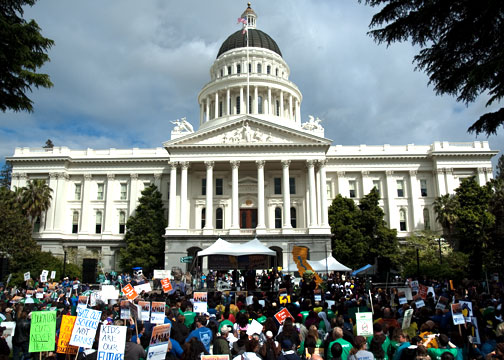Protesters move from the streets to the chambers

By Jessica Luthi
The Guardsman
California activists demanding more funding for a broad range of public services, rallied in front of the state capitol on April 21.
Related StoriesTaking it to the capitol City College demonstrators demand education SF State protesters advocate priority shift for California Berkeley students unite against budget cuts Check it out hereRaucous protestors fill SF Civic Center Area high school students inaugurate Oscar Grant Memorial Hall at SF State Students occupy library to protest cuts |
Nearly 3,000 demonstrators convened around mid-afternoon at Southside Park in Sacramento, joining a small group of marchers in the “last mile” of their 365-mile march from Bakersfield to the capitol. The group’s route through the Central Valley was modeled after the 340-mile United Farm Worker’s march led by César Chávez in 1966, according to event coordinators.
The rally and march were intended to draw attention to the negative impact of budget cuts on public education. Their timing coincided with a public joint hearing of the Assembly Budget Subcommittee No. 2 and the Assembly Higher Education Committee, which discussed the Governor’s 2010-11 budget proposals for higher education enrollment, funding and student success.
A small group of roughly 40 individuals from City College attended the event. While most just observed the hearing, Ryan Vanderpol, associated student president for the Ocean campus addressed the committees.
“As you walk through the halls the first day of class, the halls are inundated with students who can’t get into classes,” Vanderpol said. “Teachers are being asked by students ‘hey can you get me on the roll?’”
Vanderpol added that because it’s difficult for students to get into classes, often it puts them behind almost an entire academic year.
At City College, the summer 2010 semester has been completely eliminated and classes have been reduced. Additionally, the amount of services students receive has decreased including shorter library hours, and less counseling and administrative services.
“The crisis that education is facing is hard amongst all the students, faculty, and teachers,” said Dora Palacios, 48, a City College student and General Assembly member. “All of them are getting hurt.”
Patrick Lenz, UC vice president for budget and capital resources said funding education should be a top priority to ensure student success.
Activists are demanding that the legislature increase funding for programs and services on all levels of public higher education — UCs, CSUs and community colleges.
“We are here to bring awareness of the cuts to classes, faculty and students,” UC Davis student Chris Kortright said.
Colleges and universities are over their enrollment caps because large numbers of students have been admitted, said Robert Turnage, assistant vice chancellor for the CSU system’s budget. He added that campuses are over capacity and struggling to keep up with the costs of education while trying to provide students with services.
“Current enrollment levels cannot be sustained at the current funding level,” Turnage said.
Many impacted programs at CSU and UC campuses require additional applications and documents, which makes transfer from a community college more difficult.
The on-going struggle to secure funding for education has inspired cooperative action between students, faculty and classified staff on campuses across the state, which manifested in the
General Assembly formed at UC Berkeley in October, 2009. The GA has since organized high-profile protests such as the Day of Action on March 4.
While she encourages students to stand up and be heard, Associate Vice Chancellor of Government Relations Leslie Smith is also hoping students will learn to better understand the legislative process and become participants in it.
“Now is the time to cross the line from marching, get into the Capitol and see the exact arena where the decision process is made,” Smith said. “The idea is to move them beyond the march — beyond the yelling.”
Smith is planning another trip up to Sacramento on May 5 to get students familiar with the decision-making process. The trip will not be a march or rally but a chance for students to sit in on a public hearing to grasp a better understanding of the decision-making process, she said.
Students, faculty and staff that are interested in participating in the trip can visit: www.ccsf.edu/sm for more information.
